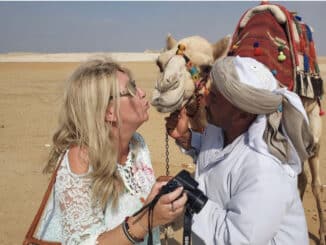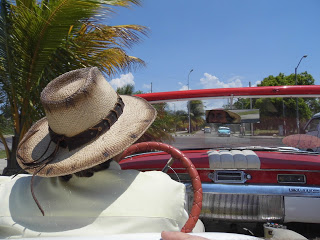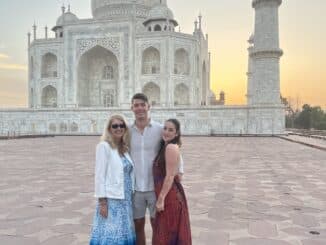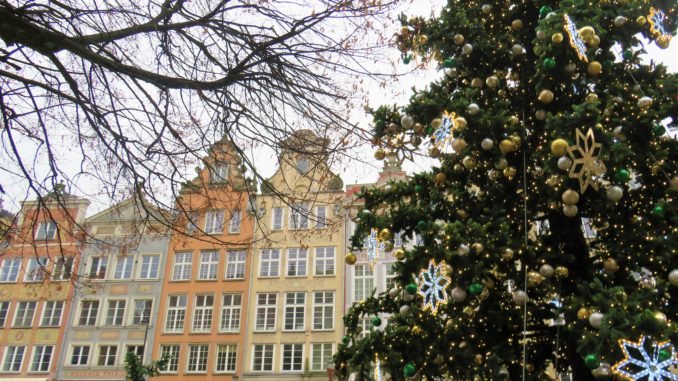
Newstalk December 11th 2019 Gdansk Christmas Markets
listen back to podcast here https://www.newstalk.com/podcasts/
This week we are off to Poland where I got more than I bargained for at the Christmas Markets. I brought along my daughter Nicole who is fascinated by the Second World War and Gdansk is where the first shots were fired so this was a cultural trip as well as a shopping trip.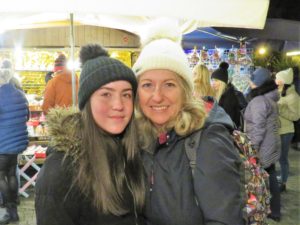
Gdansk is in Pomerania which was west Prussia, Gdansk is a city of 65,000 making it easy to get around and part of the tri-city group of Gdanyia and Sopot, a beachside resort popular in summer.
Money:
The Poles use Zloty not Euro and there are ATMs everywhere making it easy to get cash, even at the markets – there’s one as you reach arrival at the airport.
How to get there:
Ryanair have direct flights daily and they are early in the morning and as the airport is only about twenty minutes away we were in the city centre in no time. I was travelling with my teenage daughter so we went on a package with the Travel Department who are great for looking after you from the moment you land, and we were put up in a city centre hotel Qubus which is in an excellent location on granary island set right beside the old town and all the attractions. Our guide Agnes brought us on an orientation tour of the main spots as is usual with the travel department so we were very well set up from the beginning of the trip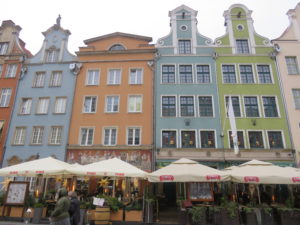
The Old Town really is the place to explore with only two main streets that run parallel from the river Motlava – During the Second World War Gdańsk was heavily bombed – in fact 90% of the beautiful architecture in the old town was destroyed but thanks to some vision the old city plans from 17th century were used to rebuild the cobbled streets and pretty facades of the Hanseatic style houses (The Hanseatic league were merchants of northern Europe spreading from Brugges in Belgium across northern Europe to Eastern Prussia and including Gdansk) which have been perfectly reconstructed in exact detail. Even the paintings on the facades remain the same. Agnes took us on a tour as part of our package and it was a great start to the holiday and made get our bearings easy.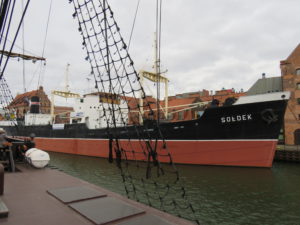
Gdansk is filled with lovely restaurants cafes and bars and you will see many amber galleries. All around the Baltic coast deposits of amber are prevalent and none more so than the southern Baltic where Gdańsk sits like a jewel.
What exactly is amber?
Confused with a stone amber is actually a resin formed over thousands of years from decayed trees. It holds life forms found millions of years ago when the region was filled with tall tropical palms. 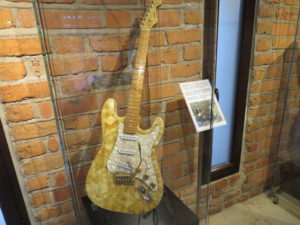 We get to see some of these in the Amber Museum which is in one of the oldest remaining buildings. Museums are really cheap – it was 12 zloty to go here which is about €3. We saw incredible specimens of insects that were millions of years old and then artefacts from cabinets to electric guitars and of course jewellery.
We get to see some of these in the Amber Museum which is in one of the oldest remaining buildings. Museums are really cheap – it was 12 zloty to go here which is about €3. We saw incredible specimens of insects that were millions of years old and then artefacts from cabinets to electric guitars and of course jewellery.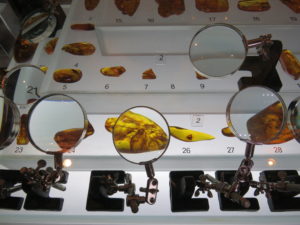
History:
My daughter is fascinated by the Second World War and Gdansk has one of the best museums of this period in history. Gdansk, which was then called Danzig, is where it all started on September 1st 1939 when Germany invaded an outpost of the polish army. In fact the exact spot is marked outside the town by a brick tower at the Westerplatte peninsula. Here the first shots were fired and only half an hour away the first concentration camp was opened at Stotthof and it remained the longest serving camp of the war too. After the war the area was joined with Poland and under the communist regime with the Gdansk shipyards being an important port.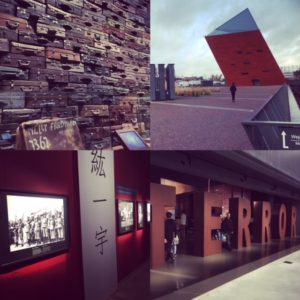
Similar to the Titanic in Belfast the Museum of the Second World War reminded me of the impressive likeness in structure and detail. The footage at the displays is excellent and it goes into every single effect of the war on society around the world. Things like ration books and cattle trucks used to transport prisoners to the camps really brought the horror and terror to life. The uniforms and the armoury is cleverly explained with samples of music listened to by the soldiers – we hired audio guides which were excellent. In total we were over 2.5 hours there and the time flew – it’s important not to forget how and why it happened and it especially explained it to my daughters generation who have had little exposure to this time in history.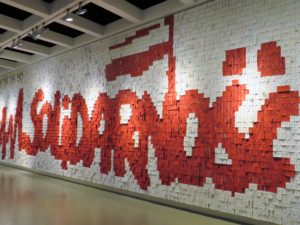
Lech Walensa Legacy:
I spoke to plenty of people who had met Poland’s greatest figure, president and Nobel Peace Prize winner. He has offices now in the European Solidarity Center not far from the Second World War Museum and if you’re lucky you can walk by him on the corridor – again this museum is equally excellent and explanatory and it’s cheap – €4 for adults and less for kids – an audio guide was only €2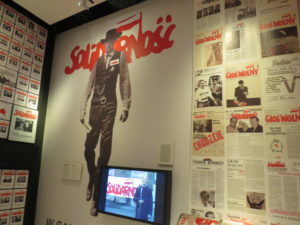
End of Cold WAR
I have to admit I didn’t realise that the strikes of the shipyard workers in Gdansk started the ripple effect that ended the cold war and the solidarity movement was the initial spark that went on to feed the flame and hunger for human rights that followed. It also showed the importance that Pope John Paul II role was in the lifting of communism in the region.
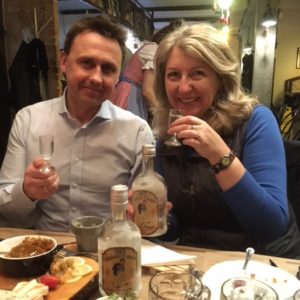
We gained insight into the most powerful story of the 20th century told eloquently and with ease at two of the most well put together interpretive centres I’ve visited.
Food: This was perhaps my biggest surprise because I found lovely places to eat scattered all over the old town. I tried some of them at Gdanski Bowke which is a traditional restaurant on the harbour – owned by Adam Kalenski, who actually went to school with Lech Walensa’s son.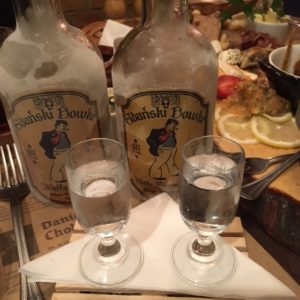
I sampled the potted herring and was amazed at the flavour of the tartar – they brew their own vodka too which is like poteen and made from potatoes. One of the most important dishes to try is Perogi which are dumplings and you can buy 7 for €2,50 at the Christmas markets and the Zurek soup which was really delicious at Gdanski Bowke https://gdanskibowke.com/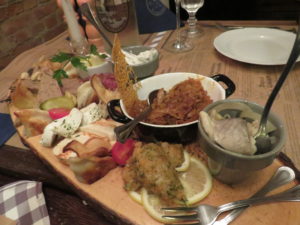
The Gdanski Bowke were the characters you’d find at the docks, even in medieval times Gdansk was a port of trade and shipping and the largest base for the transport of grain – the massive crane is a symbol of the city and is really close to this restaurant – the local dock workers were fond of the vodka and cavorting so they were given this name.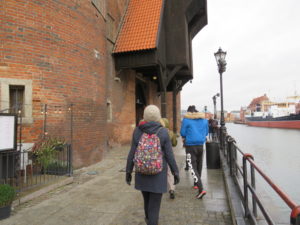
Cafes: For a traditional cafe go to Pollowski which is a bakery and here you can get the famous donuts – it is directly opposite the famous fountain and sculpture of Neptune that is half way on the Long Market road and main street in the old town. It has the Green Gate at the port side and the Golden Gate which ends at the Amber Museum.
Goldwasser: If you want a posh meal then Goldwasser is a lovely property on the port and next to the medieval crane with seven boutique apartments upstairs and gorgeous menu in its restaurant downstairs –
It’s rather posh and really busy so you would want to book if going here in summertime – the prices will amaze as the chateaubriand was under €20 and they actually sell the famous Goldwasser liquer which has special medicinal properties which is meant to heal those with a bad back … https://goldwasser.pl/. Actual gold leaf is used in the secret recipe to healing and floats around the bottle.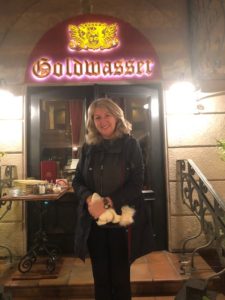
Where to stay? Our hotel, the Qubus, was really lovely with a spa in the basement called Diamond Spa and we treated ourselves to a massage. The one thing I have to say is that it is incredibly cheap – it was €40 each for an hour long massage and they have a sauna also –
Things to do:
We went on a boat trip which was really good fun in a pirate galleon called The Black Pearl and it looks exactly like the ship used in the movie Pirates of the Caribbean. http://www.czarnaperla-czarter.pl/index.html The tour lasted 90 minutes and we were taken through the shipyards and past Westerplattes where the first shots of the Second World War were shot. They served delicious food and drinks on board and is reasonably priced at It took us past the Amber Eye which has terrific views of the town and is similar to The London eye!
Another good thing to do is a bike tour which I would have done with my son but my daughter wasn’t having any of it – they run every morning at 10am for three hours and are only €25 per person https://polandbylocals.com/
This is one of the best ways to enjoy any city and it is always best to have gloves to hand when taking a tour in winter.
Gdansk is booming: There were cranes everywhere and lots of building going on – they seem to have benefited by not being in the euro and happy with the status. A few people referred to a slow down however it is a busy bustling city and the main shopping mall was buzzing with stores that you won’t get in Ireland such as Sephora and Bath and Body works…of course I ended up there for a couple of hours being with my teenage daughter.
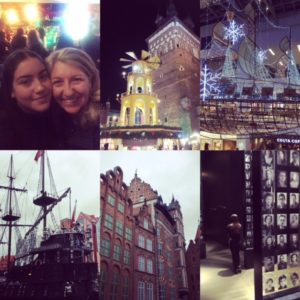
The Christmas Markets: We bought nice decorations and novelty socks etc but the best buy at the market was amber jewellery! The food at the Christmas Markets had huge choice with everything from churros to currywurst and we met a great character called Mati who wanted to talk to everyone in Ireland he used to work as a chef in Dublin and he gave me a pile of gingerbread to bring home at a knockdown price!
For all you need to know about Gdansk see www.visitgdansk.com
The Travel Department have Packages for Gdansk in 2020
Gdansk city tour 2020 fact box:
- Flights from Dublin to Gdansk
- 3 Nights B&B Accommodation
- Guided city tour of Gdansk
- Free time for sightseeing and shopping
https://www.traveldepartment.ie/holiday-types/city-breaks/
Telephone Number: 01 637 1650

